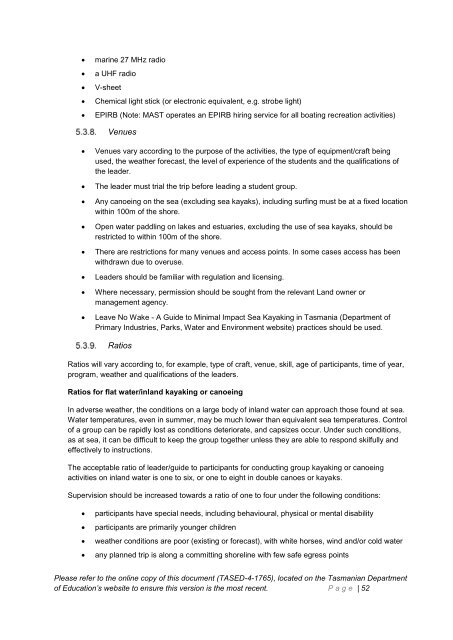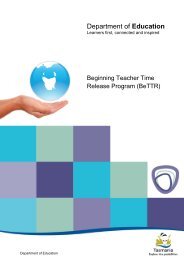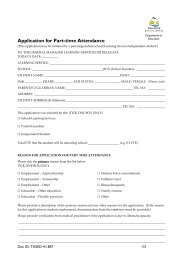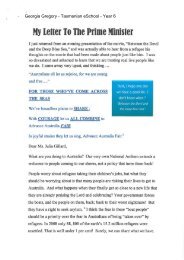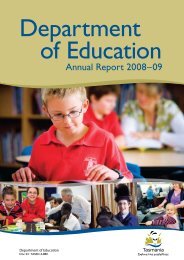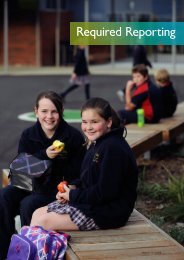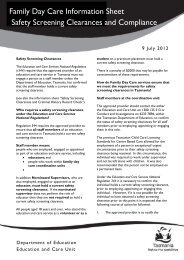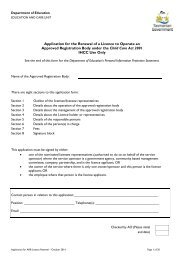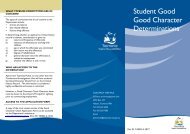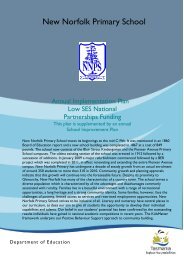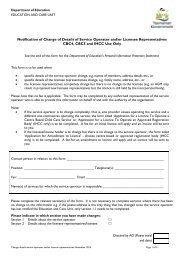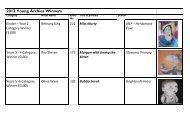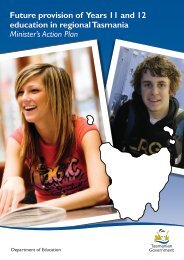PLANNING OFF CAMPUS ACTIVITIES
Procedures for Planning Off Campus Activities - Department of ...
Procedures for Planning Off Campus Activities - Department of ...
- No tags were found...
You also want an ePaper? Increase the reach of your titles
YUMPU automatically turns print PDFs into web optimized ePapers that Google loves.
marine 27 MHz radio<br />
a UHF radio<br />
V-sheet<br />
Chemical light stick (or electronic equivalent, e.g. strobe light)<br />
EPIRB (Note: MAST operates an EPIRB hiring service for all boating recreation activities)<br />
Venues<br />
<br />
<br />
<br />
<br />
<br />
<br />
<br />
<br />
Venues vary according to the purpose of the activities, the type of equipment/craft being<br />
used, the weather forecast, the level of experience of the students and the qualifications of<br />
the leader.<br />
The leader must trial the trip before leading a student group.<br />
Any canoeing on the sea (excluding sea kayaks), including surfing must be at a fixed location<br />
within 100m of the shore.<br />
Open water paddling on lakes and estuaries, excluding the use of sea kayaks, should be<br />
restricted to within 100m of the shore.<br />
There are restrictions for many venues and access points. In some cases access has been<br />
withdrawn due to overuse.<br />
Leaders should be familiar with regulation and licensing.<br />
Where necessary, permission should be sought from the relevant Land owner or<br />
management agency.<br />
Leave No Wake - A Guide to Minimal Impact Sea Kayaking in Tasmania (Department of<br />
Primary Industries, Parks, Water and Environment website) practices should be used.<br />
Ratios<br />
Ratios will vary according to, for example, type of craft, venue, skill, age of participants, time of year,<br />
program, weather and qualifications of the leaders.<br />
Ratios for flat water/inland kayaking or canoeing<br />
In adverse weather, the conditions on a large body of inland water can approach those found at sea.<br />
Water temperatures, even in summer, may be much lower than equivalent sea temperatures. Control<br />
of a group can be rapidly lost as conditions deteriorate, and capsizes occur. Under such conditions,<br />
as at sea, it can be difficult to keep the group together unless they are able to respond skilfully and<br />
effectively to instructions.<br />
The acceptable ratio of leader/guide to participants for conducting group kayaking or canoeing<br />
activities on inland water is one to six, or one to eight in double canoes or kayaks.<br />
Supervision should be increased towards a ratio of one to four under the following conditions:<br />
<br />
<br />
<br />
<br />
participants have special needs, including behavioural, physical or mental disability<br />
participants are primarily younger children<br />
weather conditions are poor (existing or forecast), with white horses, wind and/or cold water<br />
any planned trip is along a committing shoreline with few safe egress points<br />
Please refer to the online copy of this document (TASED-4-1765), located on the Tasmanian Department<br />
of Education’s website to ensure this version is the most recent. P a g e | 52


